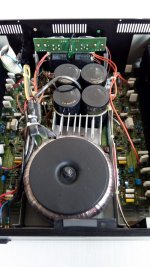The HCA1200 is one of my power amps and I am fairly sure that I could supply a schematic. It has the right topology, representative of just about everything I make today.
The HCA1200 is one of my power amps and I am fairly sure that I could supply a schematic. It has the right topology, representative of just about everything I make today.
I wouldn't mind resurrecting this it looks to drive anything I would ever use. Kindhornman PM me and we can talk.
Recently gotten into metal working as an art form, Scott? 😀
(That's a compliment, John, in case there's any question)
(That's a compliment, John, in case there's any question)
Here is the HCA 1200 schematic. It is one of my first designs of the type that I use today.
Attachments
Last edited:
Just curious- it looks like you have two bias trimmers in series? Is that the case or is it my old eyes not seeing a connection on the schematic? If so, what's the trick?
The Taiwanese engineers added the extra pot. I am not sure why. Maybe they had more 1Kpots and fewer 2Kpots. They added extra caps in the power supply as well, etc, etc. I just ignored these changes until they started messing up the design (like in the HCA-3500) where I realized that I had to ride herd one them closer to keep the design subjectively OK.
Here is the HCA 1200 schematic. It is one of my first designs of the type that I use today.
I would be honored to get one of these up and working to original intent. John I wish you would understand that we all respect the work that you have done.
.
Last edited:
is it my old eyes not seeing
At age 61, you must have encoreked too many
Scott,
I'll PM you. So the question is are there things that could be done to this amp that would improve it? I ask because I have two of these amps. the one I blew in bridged mode, and another that works just fine.
Scott, all I can tell you is I messed up on a xo I was working on for a three way system and the impedance at some point must have dropped very low or the capacitance was such that the amp went into an oscillation and before I could literally turn the amp off it was over, just dead. No magic smoke that I remember, just dead.
I'll PM you. So the question is are there things that could be done to this amp that would improve it? I ask because I have two of these amps. the one I blew in bridged mode, and another that works just fine.
Scott, all I can tell you is I messed up on a xo I was working on for a three way system and the impedance at some point must have dropped very low or the capacitance was such that the amp went into an oscillation and before I could literally turn the amp off it was over, just dead. No magic smoke that I remember, just dead.
if it won't cause trouble, please share what you find out.
i'm curious to know if there might be any changes in how the compensation is done that might make improvements.
maybe john has a comment on such an idea since this amp has been around for several years?
mlloyd1
i'm curious to know if there might be any changes in how the compensation is done that might make improvements.
maybe john has a comment on such an idea since this amp has been around for several years?
mlloyd1
Scott,
... So the question is are there things that could be done to this amp that would improve it? I ask because I have two of these amps....
.
This is a B level amp, and is 23 years old. There have been at least 4 separate model changes since then. Still, it was a good 'workhorse' for the time.
According to the pic, the two trimpots are not identical....likely setup as course and fine bias adjustments.Just curious- it looks like you have two bias trimmers in series? Is that the case or is it my old eyes not seeing a connection on the schematic? If so, what's the trick?
Bias adjustment on many amps is really touchy......I have thought of this course/fine arrangement in the past, now I see it.
Good work Parasound guys.

PARASOUNDHCA-1200II-2x315WattsRMS-HighCurrentPowerAmplifier
Dan.
The two pots are probably the same. So what? They added the second pot for some reason, but I don't know why. Perhaps they wanted to keep the symmetry of the design. Perhaps they had a special method of setting the pot. Or perhaps they wanted to double the resolution, compared to a single 2K pot. In any case, it is irrelevant to the operation of the amp. There are many other improvements possible, what are they?
Here is the HCA 1200 schematic. It is one of my first designs of the type that I use today.
That is one fine looking beastie!
🙂
Last edited:
We are clearly talking past each other at this point.
No, not at this point. 🙂
Did I not state that triangle/tetrad protocols enjoy greater statistical power? That's exactly what comes out of the abstract and makes solid statistical/experimental sense.
You did state that but unfortunately it isn´t true and neither abstract nor the article confirms your assertion. 😉
The article mainly compares triangle with tetrad and indeed tetrad has the advantage of greater statistical power (compared with triangle) but people suspected that it´s sensitivity might be lower which would, if true, counteract the power advantage.
After that the authors did additional preference tests which were significant even in the case where the tetrad didn´t give a significant result:
"Therefore, it was concluded that even for small sensory differences, and in conditions where sensory fatigue could play a greater role (resampling allowed), the tetrad test sill appears like a good alternative to the triangle."
and
"Such significant preferences were found for three out of the four conditions, including the one with the smallest difference for which a significant result had not been found with either the tetrad or triangle. The non-significant preference in the fourth condition was attributed to segmentation in the
population."
(both quotes taken from the abstract)
In addition they provided sample size calculations for tetrad and preference test (same conditions- power = 0.8, alpha=0.05 and d´=0.54):
"a sample size of 568 would be necessary for the tetrad test. On the other hand, a preference test (modeled as a 2-alternative forced choice) would need a sample size of 78 for the same specifications.
(R. Ishii, M. O’Mahony, B. Rousseau. Triangle and tetrad protocols: Small sensory differences, resampling and consumer relevance. Food Quality and Preference, Volume 31, January 2014, Page 54)
I admitted I didn't know the official name, but I've done enough other testing where you need positive and negative controls.
I don´t doubt that, but apparently it didn´t help in our discussion... 🙂
Both are infinitely better than a simple XY test.
Which is simply wrong and an sound A/B-Test isn´t simple at all.
Anyhow, it's bad enough getting people to do remotely robust testing and we're arguing even more specific protocols.
The demand for "robust testing" is often used as a knockout argument combinded with the underlying assertion that "anything blind" will do (i know exaggerated, but used just to illustrate the point ) .
There is much to say about sensory tests as it is a complex field. Methods do have different strengths (and disadvantages) the statistical analysis (and efforts to compare the various protocols) rely on different models for the cognitive processes involved (the cited article used a thurstonian approach); did i already mention that there exists a plethora of literature? 🙂
Our discussion is telling; i provided a short description of a test we had done, you were shooting from the hip that surely another protocol would have been much better and another poster immediately added an unsubstantiated ad hominem attack after i questioned your assertion.
Last edited:
- Status
- Not open for further replies.
- Home
- Member Areas
- The Lounge
- John Curl's Blowtorch preamplifier part II
